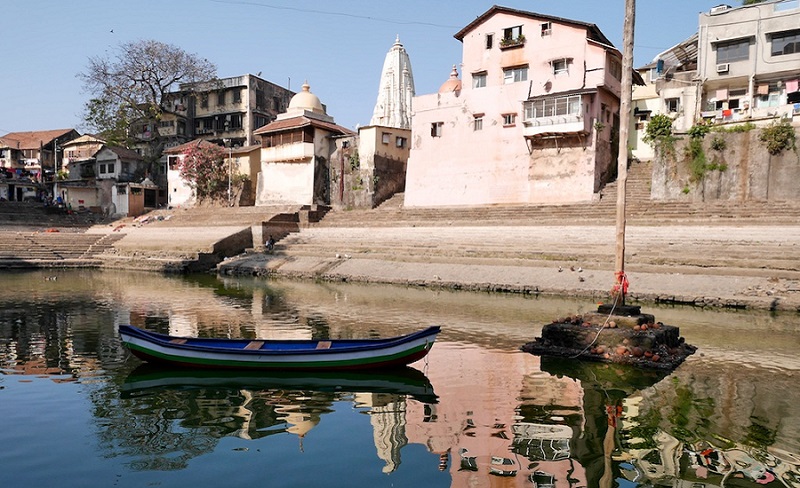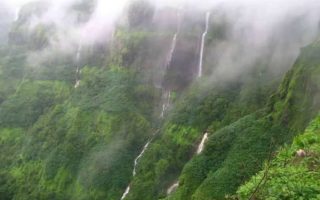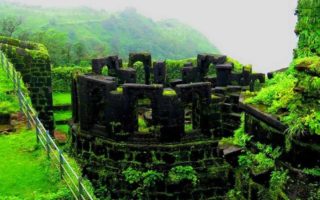- Location: Banganga road, Malabar Hill, Mumbai
- Deity: Lord Rama
- Dedicated to: Valuka Ishwar (Lord of Sand)
- Popular for: Banganga Tank
- Main attraction: Annual Hindustani Classical Music Festival
- Best season to visit: From October to March, especially during January month
- STD Code: 022
In India, Maharashtra state where innumerous pilgrimage centers are present which belongs to different religion of Hindus. Among all of them, the Walkeshwar Temple or simply known as the Lord of Sand temple is a most popular sacred place in Mumbai. It is an oldest traditional site which is located in Mumbai city of Maharashtra state. This holy shrine is situated on the stunning Malabar Hill. According to the legend tales, the initial temple, which was constructed by Shilahara was demolished by the Portuguese people when they ruled Mumbai island in the earlier century of 810 to 1260 A.D.

But later on, this temple was reconstructed by Ram Kamat in the year 1715. According to mythological stories of Hindu religion especially in Ramayana, it is said that Lord Rama rested in this sacred place while he was on his way to release his beloved wife Sita in Lanka. Therefore, he built a lingam from sand in this place which meant one of the important symbols of Hinduism. The original Walkeshwar Temple was destroyed by the Portuguese and the sand lingam is said to have jumped into the sea to avoid desecration.
It is considered that Banganga is one of the streams of the religious river named as Ganga. This sacred river flows at a short distance of around thousand miles. Therefore, this place was known as Banganga because the Ban suggests an arrow and river Ganga is referred to as the Ganges. Whatever the mythological story be or legend tales, the respect to this consecrated water of the Banganga is never been questioned. Devotees from all around the world visit the Walkeshwar Temple to worship their deity with respect and to get blessings. People who follow true rituals and tradition of Hinduism they come here from far away regions within Maharashtra and outside tourist from different states.
During the religious festivals and events that are held here, a large numbers of devotees come to this holy place to take a sanctified dip in the pristine waters and offer some religious items like flowers to fulfill their wish. At present, if you see the Banganga tank it is structured in rectangular pool shape with the surroundings of a few stairs on all the four sides. As soon as you enter this sacred place, you can see two pillars erected where oil lamps or simply known as diyas which are lightened from the ancient times. Since the water in the tank continues to flows, so the taste of the water is sweet, even though it is situated few miles away from the slated sea.
Walkeshwar Temple is one of the revered Hindu sacred places, which lies on the steep slopes of Malabar Hill region, in South Mumbai. This beautiful and ancient temple is honored to Lord Shiva, who is considered to be one of the powerful Hindu Trinity of Gods. The holy temple and the mossy water of Banganga Tank are situated close to each other which were built during the earlier years of 1127. Lakshman Prabhu was honored to construct the temple; he was one of the pastors in the courtyard of Silhara Empire Kings. During the ancient period, they ruled on various parts and islands of Mumbai (Bombay) and Thane. Later the Walkeshwar Temple had to suffer from great ruination due to govern of Portuguese over this city.
Afterwards, the renovation and rebuilt of this holy shrine was carried out during the year 1715, mainly under the support of Rama Kamath. He was also known as a ‘Gaud Saraswat Brahmin,’ who was a great philanthropist and businessmen who lived in Mumbai city of Maharashtra. According to the British records, Ram Kamath was recognized as ‘Kamati’. Today, the structure of the temple you see is not the original one which was build by Kamath. The Walkeshwar Temple at present has some of the features that are acquired form the original one and therefore, it was rebuilt once again in the year 1950. As time passed, numerous small holy shrines were built in the vicinity of Walkeshwar Temple and also around the sacred place Banganga Tank.
This tank is located close to this sacred temple therefore; sometime it is also called as Banganga Temple. To witness this sacred place is Mumbai city of Maharashtra, numerous devotees and visitors hail here to worship their Hindu deity. as per the lunar calendar, a large amount of crowd can be seen in this temple during the new full moon day that is on ‘Purnima’ and also no moon day that is ‘Amavasya’ of each month. The pirates of Malabar who used to hail to this isle of Mumbai during the previous era of 16th century, without fail used to visit this temple. Besides, a popular pilgrim center of Maharashtra, the Walkeshwar Temple is also renowned for its striking and exquisite architectural style that beholds the eyes of visitors.
Myth
According to the legend stories, it is believed that the Hindu god named Lord Ram took a halt while he was on his way from Ayodhya to rescue his wife Sati in Lanka. She was captured by a demon named as Ravana, who was the king of Lanka city. Later on, Lord Rama suggested showing devotion towards Shinlingham and then he constructed a beautiful lingam which was made of sand. Lord Rama got tired after waiting a long time for his younger brother called Lakshman to get an idol. The name of this temple is etymologically gained from a Sanskrit name which is known as ‘Valuka Iswar’, it means an idol constructed by sand.
According to the mythological tales, it is said that the idol which they made from sand was built in an avatar of Lord Shiva.
In some of the Hindu religion, it is said that when Lord Rama was thirsty for water, there was no facility offered for fresh water around him except for sea water. So to quench his thirst he shot a pointed arrow and made way for Ganga River over here. Bana is derived from the Sanskrit language which means arrow released from a Bow. The water fills the Banganga tank comes from an under the level of ground at this spot contains sweet water, despite the closeness to sea.
Festival
The Banganga Tank, located closure to the Walkeshwar temple, serves one of the famous venues for organizing a “Hindustani classical music festival.” This musical event is mainly hosted by the ‘Maharashtra Tourism Development Corporation’ or (MTDC) each year. It is usually celebrated during the month of January. In this festival, various artists and some amateurs who are related to music field come here to be a part, while the visitors and tourist witness this festival as an audience to look at the performances by the skillful musicians. Various concerts and live musical shows are held in the Walkeshwar Temple that attracts local residences and also tourists who hail here to witness this revered place.
Recently, in the year 2005 an annual concert of ‘Hindustani classical music festival,’ featured numerous great musicians of classical singers Sajan and Rajan Mishra, and Shivkumar Sharma of Santoor maestro. At present, the Banganga tank in the Walkeshwar temple is one of the esteemed venues for organizing an annual Festival of Hindustani classical music festival. This festival is the most popular and a vibrant occasion which fills the air with classical rhythms played from Indian instruments in live musical shows and concerts invoke the musical extravaganza in mind of the people.
Other Attractions Closure to Walkeshwar Temple
There are various major attractions that are situated in the neighborhood from this famous pilgrimage site of Mumbai city in Maharashtra. While exploring in this place, you can also come across some of the spots that worth to witness here. Other sacred places of Hindu religion that are located here are as followed :-
- Mumba Devi Temple
- Shree Siddhivinayak Ganapati Mandir
- ISKCON Temple
- Vaishno Devi Temple
- Mahalaxmi Temple
- Babulnath Temple


